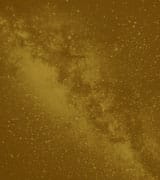Astronomical Ephemeris – October, 2021
Astronomical Ephemeris – October, 2021
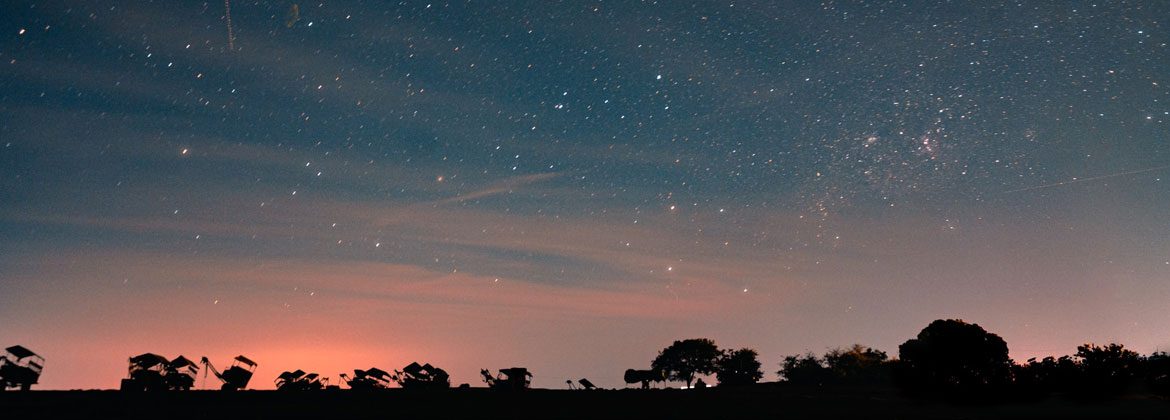

Five events highlighted in the October night sky in both the northern and southern hemispheres, with the possibility of observation with the naked eye, will invite us to observe the firmament and feel a little, or a lot, of the universe of which we are a part.
Moon phases
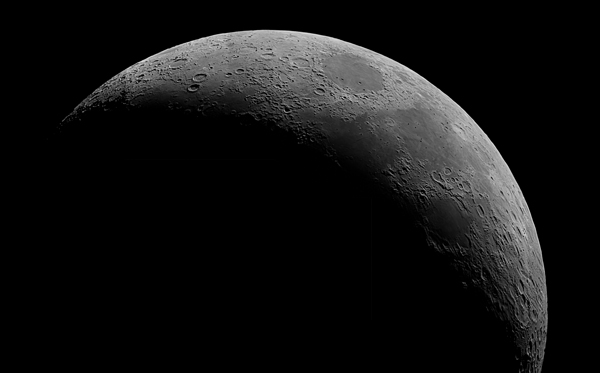
October 6 – New Moon
October 13 – First Quarter
October 20 – Full Moon
October 28 – Last Quarter
October conjunctions
In October, our bright satellite, the Moon, just like last month, will form conjunction with the planets Venus, Saturn and Jupiter.
Keep in mind that in astronomical terms, the word “conjunction” is used to designate that two or more celestial bodies are apparently very close together in the sky when viewed from the earth.
Important:
The angulations and cardinal points mentioned here have as geographic coordinate reference of the observer’s position the city of São Paulo/Brazil.
October 9
Conjunction between the Moon and Venus
At around 18:24 (Brasilia -3UTC) on October 9, the Moon will pass at 2°51’ north of Venus. This very close approach characterizes the phenomenon of conjunction between them.
At that moment, the two celestial bodies will be at 41° – an angle that varies according to the observer’s location – above the horizon line towards the west.
The Moon will shine at an apparent magnitude of -10.7 and Venus of -4.2 – both in the constellation Scorpio. We will lose visibility of the pair approximately three hours later, when they will sink below the horizon line.
This conjunction between the Moon and Venus will be visible to the naked eye or through a pair of binoculars in both hemispheres, but it will not fit within a telescope’s field of view.
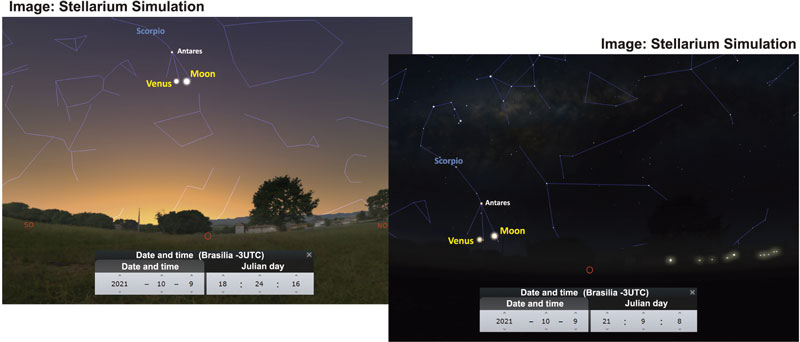
October 13
Conjunction between the Moon and Saturn
On October 13 it will be the Moon’s turn to pass 3°56’ south of Saturn forming a conjunction between them.
The pair will be visible in conjunction from 18:25 (Brasilia -3UTC), with 79° angulation above the horizon line (angle that varies according to the location of the observer), towards the east, in the constellation Capricorn, reaching 85° around 19:00 and will remain observable until approximately 0:50 on the 14, when it will sink below the horizon towards the west.
The Moon and Saturn will shine, respectively, at an apparent magnitude of -12.2 and 0.3. They will be visible to the naked eye or through a pair of binoculars in both the southern and northern hemispheres, but they will be too far apart to fit a telescope’s field of view.
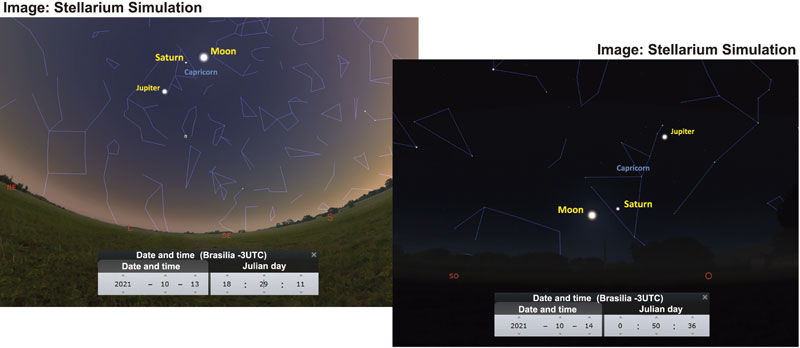
October 15
Conjunction between the Moon and Jupiter
On October 15, from 18:29 (Brasilia -3UTC), visible enough to be observed with the naked eye or through binoculars, but separated to the point that they do not fit in the visual field of a telescope, the Moon and Jupiter will form a conjunction when it passes at 4°08′ south of the gas giant. They will be at 64° angulation above the horizon line (angulation variable according to the location of the observer). Around 20:00 (Brasilia -3UTC), they will reach 81° angulation above the horizon. They will remain observable until about 1:50 (Brasilia -3UTC) on the 16 when they will sink below the horizon towards the west.
During this conjunction, the Moon will be at an apparent brightness of magnitude -12.3 and Jupiter of -2.6 – both located in the constellation Capricorn.
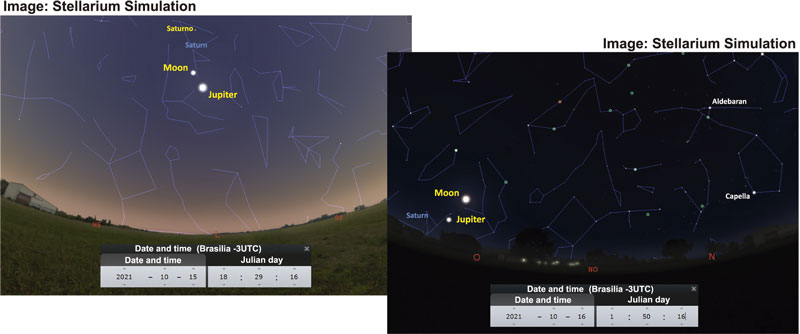
October 21
Orionids Meteor Shower
The Orionids are the second meteor shower of the year whose “parent object” is comet 1P/Halley, the other being the Eta Aquariids.
Parent object because the shower occurs when the Earth passes through the debris wake region left by Halley’s Comet; this debris enters the Earth’s atmosphere at a high speed, about 66 km/s, and burns – visually producing what we call a meteor shower.
Active from October 2 to November 7, the Orionids will peak – the time of greatest activity – on October 21 from 22:55, when it will produce an average rate of 15 fast meteors with long and fine trails per hour, remaining until before dawn.
There is a chance of seeing meteors in this period whenever its radiant point – apparent point of origin of the shower, which in this case is the constellation Orion, hence its name Orionids – is above the horizon line, but the best views take place when it it’s higher up in the sky.
To better observe this phenomenon, follow the movement of the constellation Orion in the cosmos, locate in it the popularly called “Three Kings” and its brightest stars, Rigel and Betelgeuse.
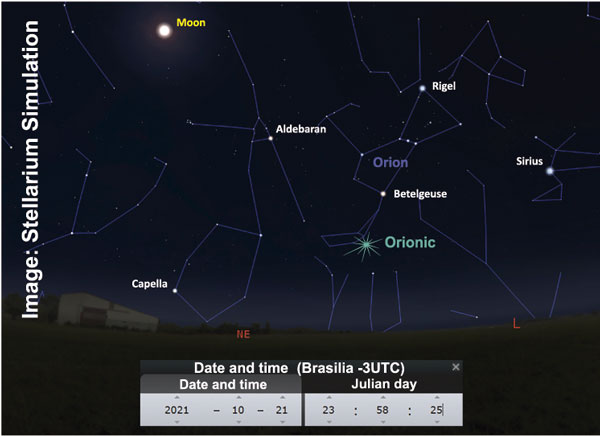
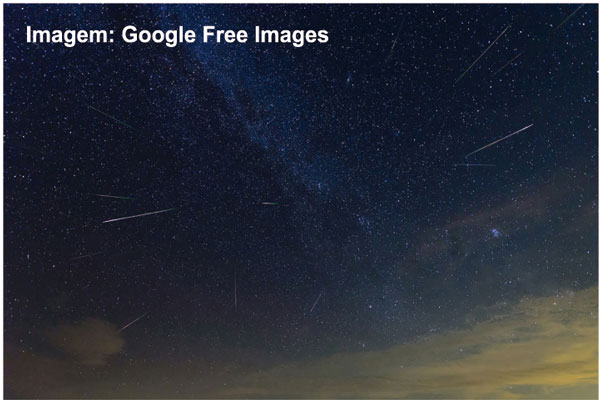
October 25th
Maximum Elongation of Mercury
Moments before sunrise on October 25, the small, rocky planet Mercury will be at maximum elongation, meaning it will be at its greatest angular distance from the solar disk.
This placement allows Mercury – which has the closest orbit to the Sun among the planets that make up our system – not to be overshadowed by the sun’s glare, and this allows for a better observation of it.
This maximum elongation of Mercury is the sixth and last to occur in 2021. It will be at 18.4° angular distance west of the Sun; therefore, to observe it, look east, approximately 11° above the line of the horizon.
Mercury will glow at an apparent magnitude of -0.6 and with 51% of its surface illuminated.
Visible around the world.
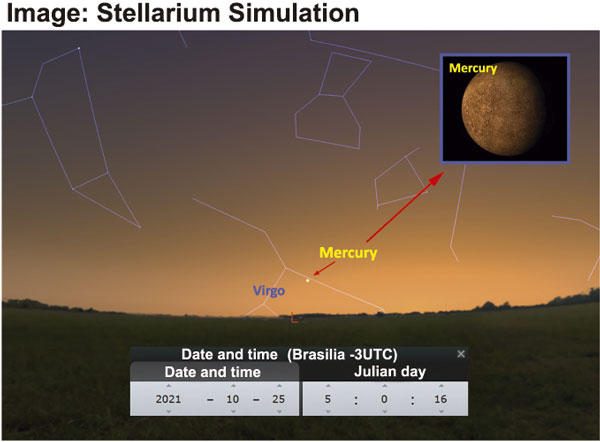
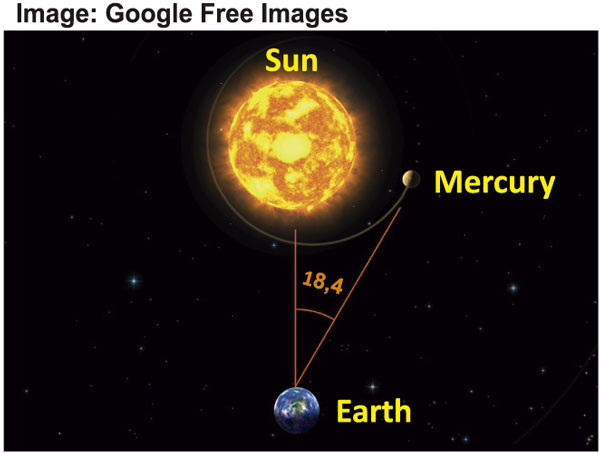
Estimating the distances of objects in the sky
For a better understanding of astronomical phenomena, it is important to understand the apparent size and distance measurement system in degrees, minutes and seconds…
Angular measurements, in degrees, minutes and seconds, allow us to calculate the size and apparent distances of celestial bodies in the cosmos.
Assuming that the Earth and the celestial vault are divided into 360 parts or degrees, we can estimate the distances and sizes of celestial bodies with just our hands, since the little finger (or pinky) corresponds to an apparent distance or size of 1 degree in the celestial vault.
The images will illustrate and show how you can make use of this system.
First, position yourself.
And then use your hand, following the convention:

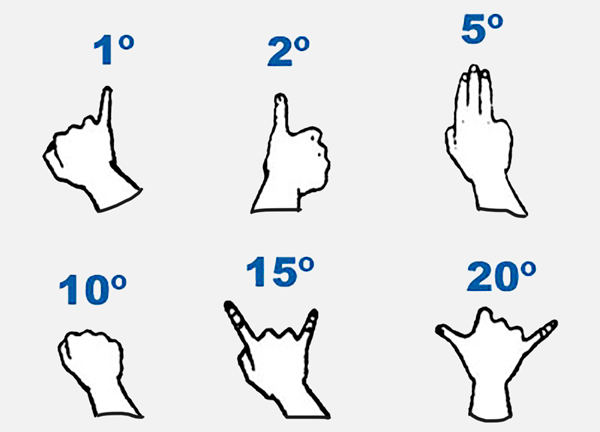
Sources: jpl.nasa.gov/calendar / solarsystem.nasa.gov / in-the-sky.org / Stellarium.org / rmg.co.uk / earthsky.org / space.com / derekscope.co.uk / planetaty ephemeris – Jet Propulsion Laboratory (JPL) / canaltech.com.br
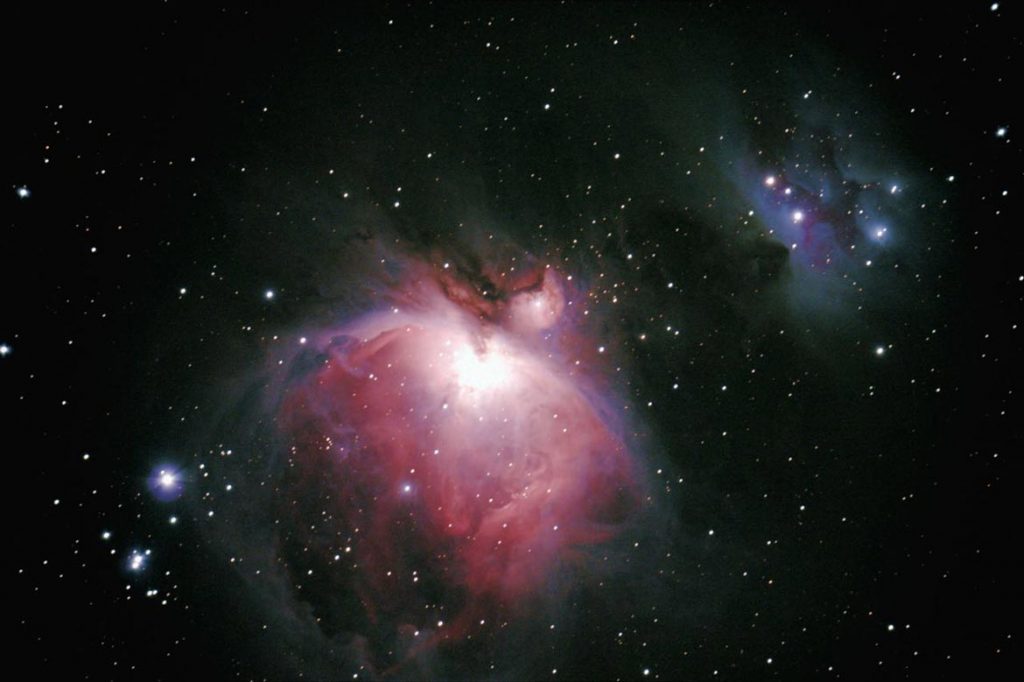
Astronomical ephemerides is a monthly calendar prepared by the Astronomy Sector, which is one of the 12 that make up the PRÓ-VIDA Laboratory Department. In the department, studies, research and scientific experiments related to various themes are developed, as well as field activities and lectures.

Astronomical ephemerides is a monthly calendar prepared by the Astronomy Sector, which is one of the 12 that make up the PRÓ-VIDA Laboratory Department. In the department, studies, research and scientific experiments related to various themes are developed, as well as field activities and lectures.

